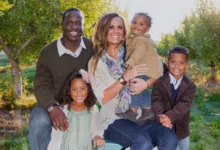Family Groups

Family Groups are social circles that exist within the family. They are often characterized by shared interests, values, behaviors, and ways of relating to each other. Family Groups can range from small nuclear families to extended families with dozens or even hundreds of members. They can also be groups of people who may not necessarily have a blood relationship but share a close bond due to living in the same household or having similar values, beliefs, and cultural backgrounds. Regardless of size or scope, Family Groups provide an important place for individuals to connect and learn from one another on many levels about.
Have you ever thought about the complex structure of family groups in different societies? How do they interact with each other and what kind of relationships do they have with third parties? In this blog post, we will address these questions and more. So stay tuned for some interesting reading!
Table of Contents
Family Groups
- The one-parent family
- The two-parent family
In every society, the family is one of the most important groups. Families provide love, support, and stability for its members. They also have a profound influence on individuals and society as a whole. Each family has its own unique structure and identity. In this post, we’ll explore the different types of families that exist and their roles in society.
The structure of a family group
A family group is a unique entity of individuals with a certain internal structure. This structure is often determined by societal norms within the group’s culture, and the rules and requirements for members to follow. The individuals making up the family group will interact in different ways based on their roles within it, such as nurturing relationships between parents and children or respecting wider bonds of kinship.
The ties that bind the family together create social interaction beyond the immediate circle, allowing them to form relationships with third parties indirectly connected to belonging to the same family unit. The structures of a family group vary globally yet always carry fundamental values which ensure its importance in society continues from generation to generation.
The relationships between a family group and third parties
Family groups are unique in the way that they interact with their environment, be it the people or institutions around them or the wider social circles that exist. This is evident when looking at the relationships between a family group and third parties; these often take on forms such as mutual aid, financial support, protection, advice, and guidance.
It is a testament to how strong the bond between family members can be since these interactions typically help each individual within them reach their maximum potential whilst also having an impact on the wider society. Through such relationships formed with third parties, families have become integral components of both local and global communities.
How family groups have changed over time
For centuries, family groups have adapted to the ever-changing political, economic, and social pressures of their respective societies. In some cases, traditional relationships between family members have been reworked or completely rewritten, to better align with the values of the individual families and wider society. As so often lies within human nature, change is seen as both a necessary evil and can also create new opportunities for development. It is safe to say however that throughout this constant state of flux, the primary purpose of a family group has persisted; to provide stability and support in times of need.
The importance of family groups in society
Family groups have long been a cornerstone of many societies around the world and are often seen as essential for keeping the social fabric intact. They provide an important structure for ensuring individuals have adequate levels of support and access to resources in times of need, while helping to structure behavior within familial networks. Families also form part of a wider societal framework, with members expected to make contributions as part of their group responsibilities.
Furthermore, family groups can be an intergenerational source of continuity and morality which serve to enrich the culture and values found within society. Therefore, it is evident that family groups play a significant role in providing social stability and fostering values among a range of generations for centuries to come.
In conclusion, it is evident that family groups and the bonds they create are of great importance. Not only do they help to provide a sense of stability and security within a society, but they also provide guidance and help when needed. Over time, the structure of family groups has changed, along with their roles in society.
Despite these shifts, family groups have always remained necessary pieces within a functioning community. As this blog post has explored, a strong relationship between family groups and third parties is essential for a healthy society as well as for individuals growing up within it.
FAQ
Question 1: What is a family group?
Answer 1: A family group refers to a social unit consisting of individuals who are connected by either blood relations, marriage, or other familial bonds. This group typically includes parents and their children, but it can also extend to include grandparents, aunts, uncles, cousins, and even in-laws. The concept of a family group varies across cultures and can encompass single-parent families, blended families with step-siblings and half-siblings, and adoptive families.
Family groups are fundamental in providing emotional support, security, and a sense of belonging to their members. They play a crucial role in the upbringing and socialization of children, imparting values, traditions, and cultural practices. In addition to the emotional and social aspects, family groups also often share financial responsibilities and living arrangements.
The dynamics and structure of family groups can vary greatly. In some societies, extended family living together or in close proximity is common, fostering a strong sense of community and shared responsibility. In contrast, other societies may emphasize nuclear families, which consist of just parents and their children.
Understanding the concept of a family group is important as it helps in recognizing the diverse forms families can take and appreciating the various roles they play in society. Family groups are not just biological constructs but are also shaped by legal, social, and emotional ties.
Question 2: What is the most common family type?
Answer 2: The most common family type, especially in contemporary society, is the nuclear family. This family structure typically consists of two parents and their children living in the same household. The nuclear family is often considered the traditional family model, particularly in Western cultures.
However, it’s important to note that the prevalence of the nuclear family can vary significantly based on geographical location, cultural norms, and socio-economic factors. In many parts of the world, extended families, where grandparents, aunts, uncles, and cousins live together or maintain close ties, are also quite common. These families offer a broader support network and are particularly prevalent in many Asian, African, and Latin American cultures.
Additionally, there has been a rise in diverse family structures in recent decades. Single-parent families, where a single mother or father raises children, are increasingly common due to various factors such as divorce, separation, or choice. Blended families, comprising of stepparents and stepchildren, often result from remarriages.
Adoptive families, where children are raised by parents not biologically related to them, and same-sex parent families, where children are raised by a couple of the same gender, are also significant and growing family types. These diverse family structures reflect the evolving nature of society and the broader acceptance of different forms of familial relationships.
In conclusion, while the nuclear family remains the most common family type in many regions, the definition of a “typical” family has expanded to include a wide range of structures, each with its unique dynamics and advantages. Understanding these varied family types is crucial in appreciating the diversity of family models in modern society.
Question 3: What is an example of a family group?
Answer 3: An example of a family group is a nuclear family, which typically consists of two parents and their biological or adopted children living together in a single household. This is one of the most recognizable forms of a family group, often characterized by strong personal and emotional bonds, direct involvement in each other’s daily lives, and a shared responsibility for the wellbeing of all members.
To provide a broader perspective, let’s consider another example: an extended family. This family group extends beyond the nuclear family to include other relatives such as grandparents, aunts, uncles, and cousins. In an extended family setup, these relatives might live together in one household or in close proximity, often playing significant roles in raising the children, providing support, and sharing resources.
Another increasingly common example in modern society is the blended family. This type of family group arises when two people enter a relationship or marriage, each bringing children from previous relationships. A blended family might include step-parents, step-siblings, and half-siblings, creating a diverse and complex family structure.
Single-parent families are also a prevalent example. In these families, a single parent raises the children, which can occur due to various reasons like divorce, separation, the passing of a partner, or individual choice. These families often demonstrate strong bonds and resilience, with the single parent fulfilling multiple roles.
Finally, a more contemporary example includes same-sex parent families, where children are raised by two parents of the same gender. Whether through adoption, surrogacy, or previous relationships, these families offer the same nurturing and supportive environment as any other family type.
These examples illustrate the diversity of family groups in today’s society. Each type of family group, with its unique structure and dynamics, plays a crucial role in the emotional, social, and economic support of its members, highlighting the evolving nature of what constitutes a family in the modern world.






